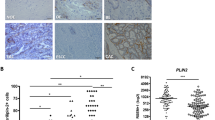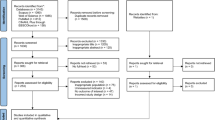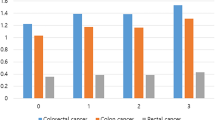Abstract
Obesity is associated with an increased risk of esophageal disorders, including esophageal adenocarcinoma, Barrett esophagus and GERD. For reasons yet unknown, the association between obesity and esophageal adenocarcinoma seems to be stronger than that for other types of obesity-related cancers. Predominantly abdominal or intra-abdominal adiposity (representing visceral fat and other fat within the abdominal cavity), which is more frequently observed in men than in women, is more strongly linked with these esophageal disorders than BMI alone, a finding that might contribute to the striking male predominance of esophageal adenocarcinoma. Research has identified potential mechanisms underlying the strong link between obesity and esophageal conditions. These findings are summarized in this Review, but more research remains to be carried out before these mechanisms are established.
Key Points
-
Obesity, particularly with a predominantly abdominal distribution of fat, is associated with an increased risk of esophageal adenocarcinoma, Barrett esophagus and GERD
-
Increase in BMI correlates clearly and proportionally with an increased risk of esophageal adenocarcinoma and GERD; however, corresponding data regarding Barrett esophagus are less clear
-
Body fat distribution, especially the presence of abdominal adiposity, is a factor in the link between obesity and esophageal disorders
-
Molecular mechanisms involving leptin, adiponectin and estrogen have been proposed to explain the association between obesity and these esophageal conditions
This is a preview of subscription content, access via your institution
Access options
Subscribe to this journal
Receive 12 print issues and online access
$209.00 per year
only $17.42 per issue
Buy this article
- Purchase on Springer Link
- Instant access to full article PDF
Prices may be subject to local taxes which are calculated during checkout

Similar content being viewed by others
References
Vial, M., Grande, L. & Pera, M. Epidemiology of adenocarcinoma of the esophagus, gastric cardia, and upper gastric third. Recent Results Cancer Res. 182, 1–17 (2010).
Lagergren, J. & Lagergren, P. Oesophageal cancer. BMJ 341, c6280 (2010).
Sharma, P. Clinical practice. Barrett's esophagus. N. Engl. J. Med. 361, 2548–2556 (2009).
Badreddine, R. J. & Wang, K. K. Barrett esophagus: an update. Nat. Rev. Gastroenterol. Hepatol. 7, 369–378 (2010).
Kahrilas, P. J. Clinical practice. Gastroesophageal reflux disease. N. Engl. J. Med. 359, 1700–1707 (2008).
WHO. Obesity: Preventing and Managing the Global Epidemic. Report of a WHO Consultation (Stationery Office Books, London, 2000).
Jaffrin, M. Y. Body composition determination by bioimpedance: an update. Curr. Opin. Clin. Nutr. Metab. Care 12, 482–486 (2009).
Andreoli, A., Scalzo, G., Masala, S., Tarantino, U. & Guglielmi, G. Body composition assessment by dual-energy X-ray absorptiometry (DXA). Radiol. Med. 114, 286–300 (2009).
Brown, L. M. et al. Adenocarcinoma of the esophagus: role of obesity and diet. J. Natl Cancer Inst. 87, 104–109 (1995).
Vaughan, T. L., Davis, S., Kristal, A. & Thomas, D. B. Obesity, alcohol, and tobacco as risk factors for cancers of the esophagus and gastric cardia: adenocarcinoma versus squamous cell carcinoma. Cancer Epidemiol. Biomarkers Prev. 4, 85–92 (1995).
Chow, W. H. et al. Body mass index and risk of adenocarcinomas of the esophagus and gastric cardia. J. Natl Cancer Inst. 90, 150–155 (1998).
Whiteman, D. C. et al. Combined effects of obesity, acid reflux and smoking on the risk of adenocarcinomas of the oesophagus. Gut 57, 173–180 (2008).
Lindblad, M., Rodríguez, L. A. & Lagergren, J. Body mass, tobacco and alcohol and risk of esophageal, gastric cardia, and gastric non-cardia adenocarcinoma among men and women in a nested case-control study. Cancer Causes Control 16, 285–294 (2005).
Engeland, A., Tretli, S. & Bjørge, T. Height and body mass index in relation to esophageal cancer; 23-year follow-up of two million Norwegian men and women. Cancer Causes Control 15, 837–843 (2004).
Merry, A. H., Schouten, L. J., Goldbohm, R. A. & van den Brandt, P. A. Body mass index, height and risk of adenocarcinoma of the oesophagus and gastric cardia: a prospective cohort study. Gut 56, 1503–1511 (2007).
Abnet, C. C. et al. A prospective study of BMI and risk of oesophageal and gastric adenocarcinoma. Eur. J. Cancer 44, 465–471 (2008).
Löfdahl, H. E., Lu, Y. & Lagergren, J. Sex-specific risk factor profile in oesophageal adenocarcinoma. Br. J. Cancer 99, 1506–1510 (2008).
Chak, A. et al. Assessment of familiality, obesity, and other risk factors for early age of cancer diagnosis in adenocarcinomas of the esophagus and gastroesophageal junction. Am. J. Gastroenterol. 104, 1913–1921 (2009).
Calle, E. E., Rodriguez, C., Walker-Thurmond, K. & Thun, M. J. Overweight, obesity, and mortality from cancer in a prospectively studied cohort of, U. S. adults. N. Engl. J. Med. 348, 1625–1638 (2003).
Renehan, A. G., Tyson, M., Egger, M., Heller, R. F. & Zwahlen, M. Body-mass index and incidence of cancer: a systematic review and meta-analysis of prospective observational studies. Lancet 371, 569–578 (2008).
Lagergren, J., Bergström, R. & Nyrén, O. Association between body mass and adenocarcinoma of the esophagus and gastric cardia. Ann. Intern. Med. 130, 883–890 (1999).
Samanic, C., Chow, W. H., Gridley, G., Jarvholm, B. & Fraumeni, J. F. Jr Relation of body mass index to cancer risk in 362,552 Swedish men. Cancer Causes Control 17, 901–909 (2006).
Nordenstedt, H. & El-Serag, H. The influence of age, sex, and race on the incidence of esophageal cancer in the United States (1992–2006). Scand. J. Gastroenterol. doi:10.3109/00365521.2011.551890.
Lagergren, J. & Mattsson, F. No further increase in the incidence of esophageal adenocarcinoma in Sweden. Int. J. Cancer doi:10.1002/ijc.2 5701.
Lagergren, J., Bergström, R., Lindgren, A. & Nyrén, O. Symptomatic gastroesophageal reflux as a risk factor for esophageal adenocarcinoma. N. Engl. J. Med. 340, 825–831 (1999).
MacInnis, R. J., English, D. R., Hopper, J. L. & Giles, G. G. Body size and composition and the risk of gastric and oesophageal adenocarcinoma. Int. J. Cancer 118, 2628–2631 (2006).
Steffen, A. et al. Anthropometry and esophageal cancer risk in the European prospective investigation into cancer and nutrition. Cancer Epidemiol. Biomarkers Prev. 18, 2079–2089 (2009).
Corley, D. A., Kubo, A. & Zhao, W. Abdominal obesity and the risk of esophageal and gastric cardia carcinomas. Cancer Epidemiol. Biomarkers Prev. 17, 352–358 (2008).
Beddy, P. et al. Association of visceral adiposity with oesophageal and junctional adenocarcinomas. Br. J. Surg. 97, 1028–1034 (2010).
Lagergren, J., Ye, W., Bergström, R. & Nyrén, O. Utility of endoscopic screening for upper gastrointestinal adenocarcinoma. JAMA 284, 961–962 (2000).
Ortiz, V. et al. Value of heartburn for diagnosing gastroesophageal reflux disease in severely obese patients. Obesity (Silver Spring) 14, 696–700 (2006).
Küper, M. A. et al. Dysfunction of the lower esophageal sphincter and dysmotility of the tubular esophagus in morbidly obese patients. Obes. Surg. 19, 1143–1149 (2009).
McElholm, A. R. et al. A population-based study of IGF axis polymorphisms and the esophageal inflammation, metaplasia, adenocarcinoma sequence. Gastroenterology 139, 204–212 (2010).
MacDonald, K., Porter, G. A., Guernsey, D. L., Zhao, R. & Casson, A. G. A polymorphic variant of the insulin-like growth factor type I receptor gene modifies risk of obesity for esophageal adenocarcinoma. Cancer Epidemiol. 33, 37–40 (2009).
Ogunwobi, O. O. & Beales, I. L. Leptin stimulates the proliferation of human oesophageal adenocarcinoma cells via HB-EGF and Tgfα mediated transactivation of the epidermal growth factor receptor. Br. J. Biomed. Sci. 65, 121–127 (2008).
Brochu-Gaudreau, K. et al. Adiponectin action from head to toe. Endocrine 37, 11–32 (2010).
Howard, J. M. et al. Associations between leptin and adiponectin receptor upregulation, visceral obesity and tumour stage in oesophageal and junctional adenocarcinoma. Br. J. Surg. 97, 1020–1027 (2010).
Doecke, J. D. et al. Single nucleotide polymorphisms in obesity-related genes and the risk of esophageal cancers. Cancer Epidemiol. Biomarkers Prev. 17, 1007–1012 (2008).
Stein, D. J., El-Serag, H. B., Kuczynski, J., Kramer, J. R. & Sampliner, R. E. The association of body mass index with Barrett's oesophagus. Aliment. Pharmacol. Ther. 22, 1005–1010 (2005).
Smith, K. J. et al. Interactions among smoking, obesity, and symptoms of acid reflux in Barrett's esophagus. Cancer Epidemiol. Biomarkers Prev. 14, 2481–2486 (2005).
Healy, L. A., Ryan, A. M., Pidgeon, G., Ravi, N. & Reynolds, J. V. Lack of differential pattern in central adiposity and metabolic syndrome in Barrett's esophagus and gastroesophageal reflux disease. Dis. Esophagus 23, 386–391 (2010).
Gerson, L. B. et al. Does body mass index differ between patients with Barrett's oesophagus and patients with chronic gastro-oesophageal reflux disease? Aliment. Pharmacol. Ther. 25, 1079–1086 (2007).
Corley, D. A. et al. Abdominal obesity and body mass index as risk factors for Barrett's esophagus. Gastroenterology 133, 34–41 (2007).
Smith, K. J. et al. Current and past smoking significantly increase risk for Barrett's esophagus. Clin. Gastroenterol. Hepatol. 7, 840–848 (2009).
Edelstein, Z. R., Farrow, D. C., Bronner, M. P., Rosen, S. N. & Vaughan, T. L. Central adiposity and risk of Barrett's esophagus. Gastroenterology 133, 403–411 (2007).
Caygill, C. P. et al. Lifestyle factors and Barrett's esophagus. Am. J. Gastroenterol. 97, 1328–1331 (2002).
El-Serag, H. B., Kvapil, P., Hacken-Bitar, J. & Kramer, J. R. Abdominal obesity and the risk of Barrett's esophagus. Am. J. Gastroenterol. 100, 2151–2156 (2005).
Akiyama, T. et al. Visceral obesity and the risk of Barrett's esophagus in Japanese patients with non-alcoholic fatty liver disease. BMC Gastroenterol. 9, 56 (2009).
Rubenstein, J. H. et al. A pilot study of the association of low plasma adiponectin and Barrett's esophagus. Am. J. Gastroenterol. 103, 1358–1364 (2008).
Sowers, J. R. Endocrine functions of adipose tissue: focus on adiponectin. Clin. Cornerstone 9, 32–38 (2008).
Rubenstein, J. H. et al. Association of adiponectin multimers with Barrett's oesophagus. Gut 58, 1583–1589 (2009).
Ryan, A. M. et al. Barrett esophagus: prevalence of central adiposity, metabolic syndrome, and a proinflammatory state. Ann. Surg. 247, 909–915 (2008).
Kendall, B. J. et al. Leptin and the risk of Barrett's oesophagus. Gut 57, 448–454 (2008).
Lagergren, J., Bergström, R. & Nyrén, O. No relation between body mass and gastro-oesophageal reflux symptoms in a Swedish population based study. Gut 47, 26–29 (2000).
Nilsson, M., Johnsen, R., Ye, W., Hveem, K. & Lagergren, J. Obesity and estrogen as risk factors for gastroesophageal reflux symptoms. JAMA 290, 66–72 (2003).
Jacobson, B. C., Somers, S. C., Fuchs, C. S., Kelly, C. P. & Camargo, C. A. Jr. Body-mass index and symptoms of gastroesophageal reflux in women. N. Engl. J. Med. 354, 2340–2348 (2006).
Murray, L. et al. Relationship between body mass and gastro-oesophageal reflux symptoms: the Bristol Helicobacter Project. Int. J. Epidemiol. 32, 645–650 (2003).
Nandurkar, S. et al. Relationship between body mass index, diet, exercise and gastro-oesophageal reflux symptoms in a community. Aliment. Pharmacol. Ther. 20, 497–505 (2004).
Hampel, H., Abraham, N. S. & El-Serag, H. B. Meta-analysis: obesity and the risk for gastroesophageal reflux disease and its complications. Ann. Intern. Med. 143, 199–211 (2005).
Corley, D. A. & Kubo, A. Body mass index and gastroesophageal reflux disease: a systematic review and meta-analysis. Am. J. Gastroenterol. 101, 2619–2628 (2006).
Solhpour, A. et al. Gastro-esophageal reflux symptoms and body mass index: no relation among the Iranian population. Indian J. Gastroenterol. 27, 153–155 (2008).
Corley, D. A., Kubo, A. & Zhao, W. Abdominal obesity, ethnicity and gastro-oesophageal reflux symptoms. Gut 56, 756–762 (2007).
Gunji, T. et al. Risk factors for erosive esophagitis: a cross-sectional study of a large number of Japanese males. J. Gastroenterol. doi:10.1007/s00535-010-0359-0355.
Zheng, Z. et al. Effects of estrogen with and without progestin and obesity on symptomatic gastroesophageal reflux. Gastroenterology 135, 72–81 (2008).
Chung, S. J. et al. Metabolic syndrome and visceral obesity as risk factors for reflux oesophagitis: a cross-sectional case-control study of 7078 Koreans undergoing health check-ups. Gut 57, 1360–1365 (2008).
Nam, S. Y. et al. Abdominal visceral adipose tissue volume is associated with increased risk of erosive esophagitis in men and women. Gastroenterology 139, 1902–1911 (2010).
de Vries, D. R., van Herwaarden, M. A., Smout, A. J. & Samsom, M. Gastroesophageal pressure gradients in gastroesophageal reflux disease: relations with hiatal hernia, body mass index, and esophageal acid exposure. Am. J. Gastroenterol. 103, 1349–1354 (2008).
Crowell, M. D. et al. Obesity is associated with increased 48-h esophageal acid exposure in patients with symptomatic gastroesophageal reflux. Am. J. Gastroenterol. 104, 553–559 (2009).
Ayazi, S. et al. Obesity and gastroesophageal reflux: quantifying the association between body mass index, esophageal acid exposure, and lower esophageal sphincter status in a large series of patients with reflux symptoms. J. Gastrointest. Surg. 13, 1440–1447 (2009).
Menon, S. & Trudgill, N. Risk factors in the aetiology of hiatus hernia: a meta-analysis. Eur. J. Gastroenterol. Hepatol. 23, 133–138 (2011).
Nilsson, M., Lundegårdh, G., Carling, L., Ye, W. & Lagergren, J. Body mass and reflux oesophagitis: an oestrogen-dependent association? Scand. J. Gastroenterol. 37, 626–630 (2002).
Nordenstedt, H. et al. Postmenopausal hormone therapy as a risk factor for gastroesophageal reflux symptoms among female twins. Gastroenterology 134, 921–928 (2008).
De Groot, N. L. et al. Systematic review: the effects of conservative and surgical treatment for obesity on gastro-oesophageal reflux disease. Aliment. Pharmacol. Ther. 30, 1091–1102 (2009).
Flegal, K. M., Carroll, M. D., Ogden, C. L. & Curtin, L. R. Prevalence and trends in obesity among US adults, 1999–2008. JAMA 303, 235–241 (2010).
Acknowledgements
The author is supported by grants from the Swedish Cancer Society and the Swedish Research Council. These funding agencies were not involved in the design or implementation of the study, the collection, management, analysis, or interpretation of the data, or the preparation, review, or approval of the manuscript. C. P. Vega, University of California, Irvine, CA, is the author of and is solely responsible for the content of the learning objectives, questions and answers of the Medscape, LLC-accredited continuing medical education activity associated with this article.
Author information
Authors and Affiliations
Ethics declarations
Competing interests
The author declares no competing financial interests.
Rights and permissions
About this article
Cite this article
Lagergren, J. Influence of obesity on the risk of esophageal disorders. Nat Rev Gastroenterol Hepatol 8, 340–347 (2011). https://doi.org/10.1038/nrgastro.2011.73
Published:
Issue Date:
DOI: https://doi.org/10.1038/nrgastro.2011.73
This article is cited by
-
Updated epidemiology of gastrointestinal cancers in East Asia
Nature Reviews Gastroenterology & Hepatology (2023)
-
Body shape phenotypes of multiple anthropometric traits and cancer risk: a multi-national cohort study
British Journal of Cancer (2023)
-
Lipid droplet biogenesis and COX-2 pathway activation are triggered by Barrett’s esophagus and adenocarcinoma, but not esophageal squamous cell carcinoma risk factors
Scientific Reports (2021)
-
Gender-Specific Risk Factors for Reflux Esophagitis in a Predominantly Hispanic Population of a Large Safety-Net Hospital
Digestive Diseases and Sciences (2021)
-
Gastroesophageal reflux symptoms among Italian university students: epidemiology and dietary correlates using automatically recorded transactions
BMC Gastroenterology (2018)



